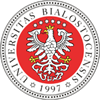Proszę używać tego identyfikatora do cytowań lub wstaw link do tej pozycji:
http://hdl.handle.net/11320/14313| Tytuł: | Objaśnienia na mapach drukowanych w XVI i XVII wieku, uczytelniające ich treść |
| Inne tytuły: | Explanations on maps printed in the 16th and 17th centuries, clarifying their content |
| Autorzy: | Szaniawska, Lucyna |
| Słowa kluczowe: | objaśnienie legenda plany miast mapy wojen mapy religii drukowane mapy z XVI i XVII wieku explanation legend city plans war maps religion maps printed maps in the 16th and 17th centuries |
| Data wydania: | 2022 |
| Data dodania: | 4-sty-2023 |
| Wydawca: | Wydawnictwa IHN PAN |
| Źródło: | Mapa a tekst, red. nauk. Karol Łopatecki, Warszawa 2022, s. 81-148 |
| Seria: | Z Dziejów Kartografii, ISSN: 0138-0850;T. 24 |
| Konferencja: | XXXIII Ogólnopolska Konferencja Historyków Kartografii „Mapa a tekst. Związki kartografii z literaturą i innymi tekstami kultury", Supraśl 16–18 września 2020 r. |
| Abstrakt: | W artykule odpowiedziano na pytanie, czy sam zbiór czytelnych znaków graficznych i ich usytuowanie względem siebie daje czytelnikowi wystarczającą wiedzę o znajdujących się na prezentowanym terenie obiektach. Udowadniając tezę, że sam zbiór znaków niestety wystarczającej wiedzy nie daje, prześledzono ewolucję sposobów objaśniania znaków umownych na mapach drukowanych w wiekach XVI i XVII. Okazało się, że równolegle twórcy map stosowali odmiennie zbudowane objaśnienia i w różny sposób układali z nich legendy. Właśnie w wybranym okresie zaczęto redagować objaśnienia, gromadząc je pod wspólnym tytułem w wyodrębnionej części powierzchni mapy. Przykłady dobrano tak, by pokazywały charakterystyczne dla epoki objaśnienia oraz uwypuklały pomysłowość europejskich twórców map co do ich formy i treści. Autorka wykazuje istotną rolę objaśnień na dawnych mapach tematycznych oraz objaśnień obiektów występujących sporadycznie na mapach ogólnoprzeglądowych. The article considers the question asked at the beginning whether the very set of legible graphic symbols and their location in relation to each other gives the reader sufficient knowledge about the objects, processes and phenomena located in the presented area, and it was found that it did not provide such knowledge. If common objects, such as rivers, mountains, forests, seas, towns and villages, were depicted on the old map, and the symbols in the shape of curved lines, mounds or vignettes imitated their actual appearance, then the readers of that time did not need t o explain their meaning. Only when they wanted to make the presentation more precise and add specific attributes, notes were added, and if there was no space, these contents were defined with graphic symbols. Especially in the discussed sixteenth and seventeenth centuries, when many newly created graphic symbols were not yet fully conventional, so were not widely known. And so, the map makers introduced the following solutions for construction and form of explanations: – they used drawing symbols on maps that had not previously been used for this purpose, e.g. Ph. Apianus on the map Bairische Landtafeln (1568), J. Blaeu on Fokien, Imperii Sinarum… (1655), P. Schenk and G. Valk on Huquang, Kiangsi, Che Kiang, ac Fokien, Provin: … (1700) and C. Allard on Portugalliae meridionales plagae… (before 1709); – when presented countries were exotic for Europeans, symbols of unknown objects usually received exhaustive explanations, as in the case of the Cairo plan by G. Braun & F. Hogenberg (1572); – in the 16th century, Latin toponyms were still in common use (e.g. thanks to numerous editions of maps in Ptolemy’s Geography), therefore their wording was combined in explanations with names in national languages, e.g. S. Münster Description nouvelle des Gaules (1552); in addition, the bilingualism of the explanations increased the scope of dissemination, as evidenced by the examples of maps: N. de Fer Kamieniec Podolski Ville Forte… (1691), B.A. Montanus Orbis tabula (1571), C. Allard Portugalliae meridionales plagae… (before 1709), H. Hondius Nova Alemanniae… (1633) and W. Jansz. Blaeu’a Prussiae Nova Tabula (1630); – they created legends to explain the words used on the maps, such as Christianographie by E. Pagitta (1635) or composed of explanations of toponyms abbreviations, as in Hispaniae Nova … by A. Ortelius (1579), as well as abbreviations of common words, e.g. river, lake, like J. Blaeu’s on Fokien, Imperii Sinarum… (1655) and G. Le Vasseur de Beauplan Delineatio Generalis Camporum Desertorum vulgo Ukraina… (1648); – the religious policy of the rulers, so important at the time, was taken into account, hence the religious affiliation was mentioned in the explanations, for example on the maps: E. Pagitta Christianographie (1635) and B.A. Montanus Orbis tabula … (1571); the attribute of religion was also used for city signatures during religious wars, e.g. on the map of S. Münster Bohemiae nova descriptio tabula XVII (1552), also in the legends of maps of areas including the neighborhood of Christianity and Islam, e.g. Delineatio Specialis Et Accurata Ukrainae… (1650) – both by Le Vasseur de Beauplana; – the need to show important attributes of objects, e.g. administrative hierarchy, official, church or princely function or subordination, such as explanations of border signs on the map Hertzogthūber Steyer, Karnten, Krain & c. Duchés De Stirie … by N. Sanson (1657), and for this purpose, the basic symbols of the objects were enriched with signatures of appropriate attributes, then combined symbols or only separate signatures of attributes were explained; this method was used in symbols of cities on country maps by T. Makowski on Magni Ducatus Lithuaniae… (1613), Novus XVII Inferioris Germaniae Provinciarum… by P. Kaerius (1617) and Nova Alemanniae… by H. Hondius (1633). Summing up, the following chapters follow the evolution of the ways of explaining symbol signs. Almost at the same time, map makers used differently constructed explanations and arranged them in legends in different ways. The selected examples show the epoch-specific explanations and highlight the ingenuity of European map makers in terms of their form and content. It should be added that in the period of the 16th and 17th centuries, chosen by no accident, explanations began to be collected under a common title in a separate part of the map surface. This undertaking was a big challenge for the map makers. The author of the article showed the important role of explanations on old maps, appreciated by many contemporary cartographers. |
| Afiliacja: | Zespół Historii Kartografii przy Instytucie Historii Nauki PAN |
| E-mail: | lucyna-szaniawska@wp.pl |
| URI: | http://hdl.handle.net/11320/14313 |
| ISBN: | 978-83-960759-9-4 |
| metadata.dc.identifier.orcid: | 0000-0002-6861-7248 |
| Typ Dokumentu: | Book chapter |
| Właściciel praw: | © by: IHN PAN & Authors |
| Występuje w kolekcji(ach): | XXXIII Ogólnopolska Konferencja Historyków Kartografii „Mapa a tekst. Związki kartografii z literaturą i innymi tekstami kultury", Supraśl 16–18 września 2020 |
Pliki w tej pozycji:
| Plik | Opis | Rozmiar | Format | |
|---|---|---|---|---|
| L_Szaniawska_Objasnienia_na_mapach_drukowanych_w_XVI_i_XVII_wieku.pdf | 11,95 MB | Adobe PDF | Otwórz |
Pozycja jest chroniona prawem autorskim (Copyright © Wszelkie prawa zastrzeżone)

